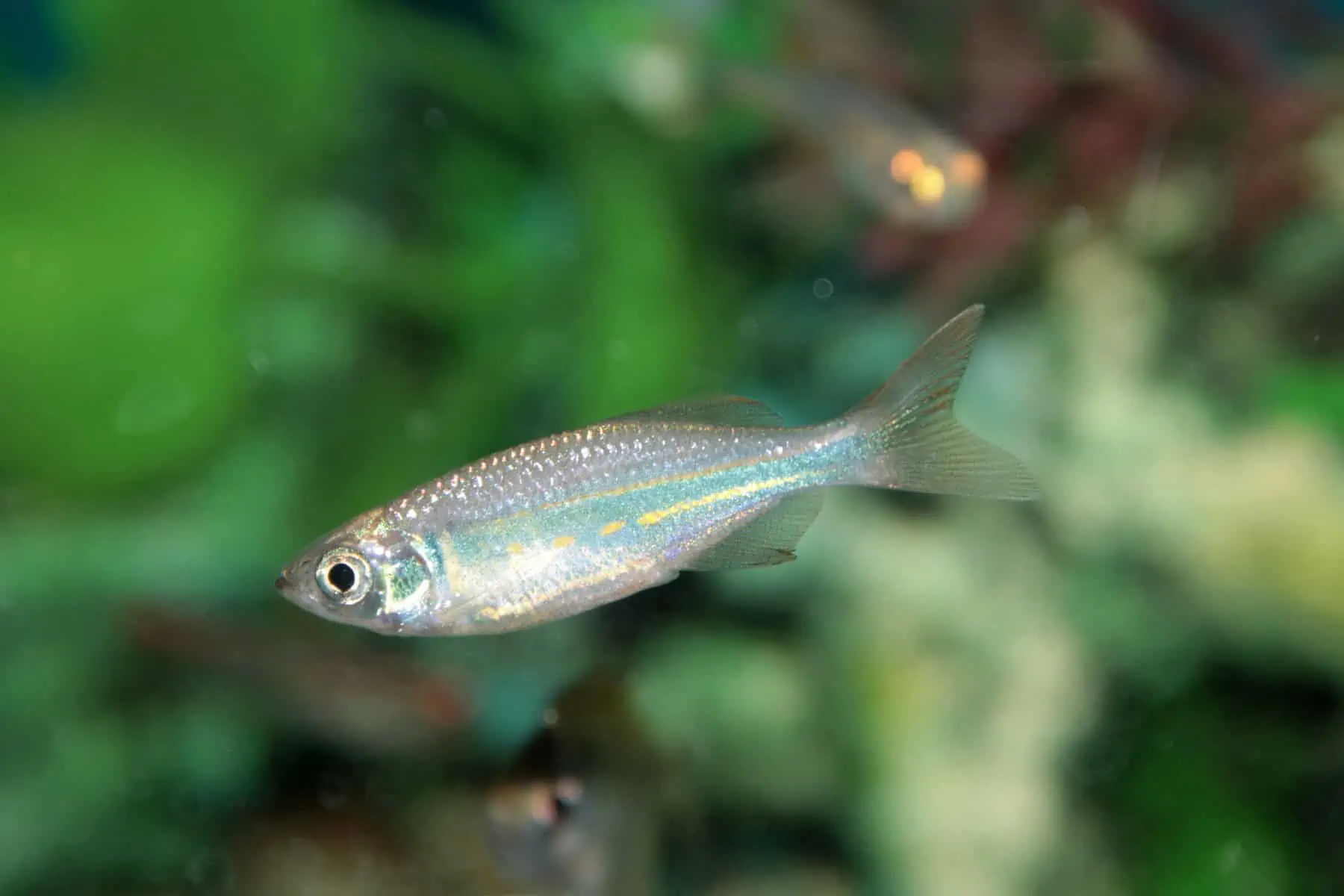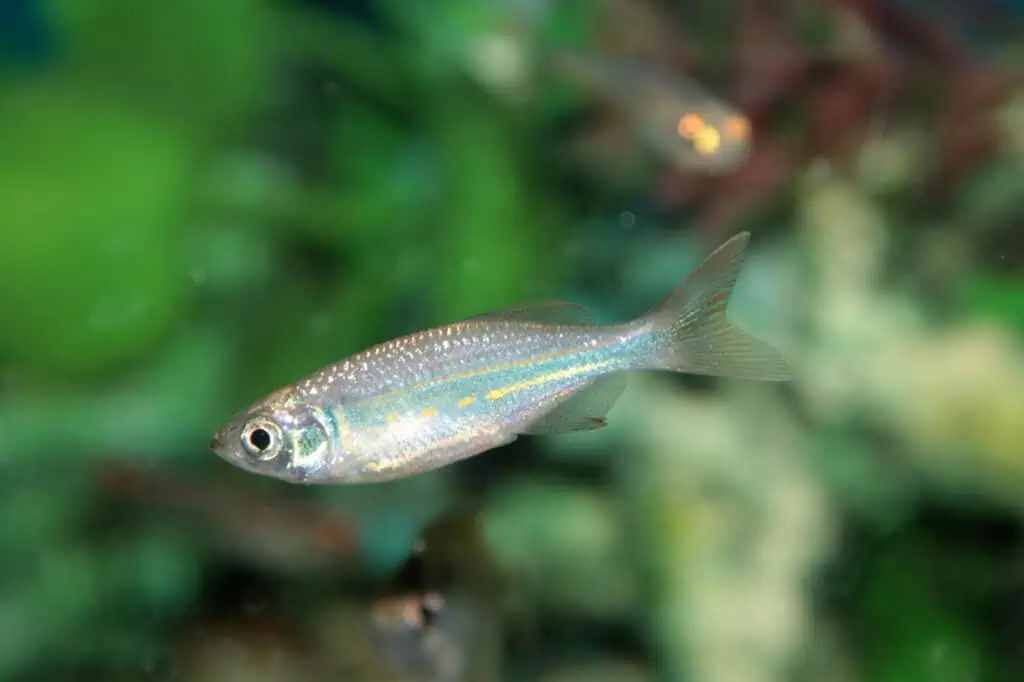Giant Danios make a great addition to a freshwater community tank. These large, active schooling fish need a big tank to accommodate them but make excellent companions for peaceful cichlids and other more sizeable species.
Read this guide to learn more about choosing, caring for, and breeding these amazing fish!
Giant Danio – At a Glance
| Giant Danio Info | |
|---|---|
| Scientific Name: | Devario aequipinnatus |
| Common Name | Giant Danio, Golden Giant Danio |
| Family | Cyprinidae |
| Origins | India, Bangladesh, Nepal, Thailand, Myanmar |
| Diet | Omnivore |
| Care Level | Easy |
| Activity | Active, schooling fish |
| Lifespan | 5 years |
| Temperament | Peaceful |
| Minimum Tank Size | 30 gallons |
| Temperature Range | 72° to 75° F |
| Water Hardness | Up to 20 dGH |
| pH Range | 6.8 to 7.5 |
| Filtration/Flow Rate | Well-oxygenated, moderate flow |
| Water type | Freshwater |
| Breeding | Egg-scatterer |
| OK for Planted Tanks | Yes |
Origins
Giant danios come from the fast-flowing mountain streams of Bangladesh, India, Myanmar, Nepal, and Northern Thailand.
Around 85 percent of fish seen in the trade are wild-caught. However, the wild population of Giant Danios is stable, and it doesn’t appear on the IUCN Red List as being threatened now.
Interestingly, the fish’s genus has changed in recent years, and it’s common to see the species referred to in literature simply as Danio. Malabar Danio (Devario malabaricus) was once thought to be the same species, but it’s since been reclassified as a closely related but separate species.
Natural Habitat
Giant Danios live in the pristine, clean water of free-flowing mountain streams or in still ponds during the dry season.
Appearance
The Giant danio has a deep body that reaches four to five inches in length in captivity and can grow even larger in the wild environment.
The fish is iridescent gold with brilliant steel blue stripes and spots that run horizontally from the gills to the tail. The fish’s fins are round in shape and pale gold colored, and the caudal fin is forked.
You can find several color variations of the Giant danio, as well as an albino.
Male or Female?
Female Giant danios are generally rounder and fuller in shape than males which are more slender than their female counterparts.
The stripe pattern on female Giant danios bends upward from the base of the caudal fin, whereas in males, the stripe is straight and extends right through the tail.
Giant Danio Size
Giant danios typically grow to between 4 and 5 inches long when tank-kept, although the fish can get larger than that in the wild.
Lifespan
These fish are relatively long-lived, often surviving for over five years.
Are Giant Danios Difficult To Keep?
Giant danios are relatively straightforward to keep and could be suitable for beginners if kept in a large enough, well-maintained tank.
Compatibility and Tankmates
Giant danios are peaceful fish that do very well in a community of fish of a similar size and temperament.
Since the danios tend to hang around the middle to upper areas of the water column, bottom-dwelling fish are generally safe to keep with Giant danios provided they are not small enough to be regarded as a food source. Non-aggressive cichlids can make good tank mates for Giant danios.
Are Giant Danios Schooling Fish?
You must keep Giant danios in schools of at least six, ideally more. If you keep small numbers of the fish, aggressive behavior toward tank mates and conspecifics can result.
Tank Mates To Avoid
Basically, you should avoid keeping small fish that could be swallowed by the Giant danios.
In addition, slow swimmers, including betta fish and angelfish, don’t make a good combination with Giant danios. The less speedy fish can easily become stressed by their faster tank mates, resulting in a compromised immune system and disease outbreaks.
Giant danios are opportunists, making a meal out of anything small enough to fit into their mouths. So, small shrimp don’t make good tank mates for these beautiful fish.
Feeding
These fish are straightforward to cater to, accepting a diet of fish flakes, frozen and freeze-dried meaty foods, and live foods if you can find a reliable supplier.
You’ll bring out the best colors of your fish if you offer them bloodworms, daphnia, brine shrimp, mosquito larvae, and the like. Be careful if you decide to offer your fish a live diet, as live foods often come with parasites and bacteria, which you don’t want in your aquarium. We recommend using frozen meaty protein instead of live food, as it’s safer.
How Often Should You Feed Giant Danios?
You should feed Giant danios twice a day, once in the morning and again before lights out in the evening. Offer the fish only what they will clear in a few minutes to prevent overfeeding.
Overfeeding your fish leads to accumulations of uneaten food in the substrate and around the tank bottom. That food gradually decomposes, polluting the water and increasing the bioload on your biological filter.
So, take the time to remove any leftovers with an aquarium vacuum cleaner, and cut down the quantity of food you give your fish. That’ll save you money too!

Tank Requirements
Tank Size
Giant danios are large fish, and you’ll need a tank that provides your school of fish with plenty of swimming space. The minimum tank size you’ll need is 30 gallons, although a larger setup is better.
These fish can have a tendency to jump when alarmed, so it’s a good idea to choose a tank with a cover slide or lid to prevent accidental escapes.
These are active fish that love to school together around their habitat, so we recommend using a long aquarium rather than a tall one.
Tank Decoration
We think a natural environment shows off these spectacular fish at their best.
To enjoy the Giant danios’ natural behavior, put most of your plants and decorations around the perimeter of the tank so that there’s space for the fish to school.
Substrate
Giant danios don’t have any special requirements when it comes to a substrate, so any kind of sand, gravel, or aquarium soil is fine.
Decorations
Natural decorations can really bring out the danios’ beauty, so choose driftwood, twisted roots, smooth stones, Dragon rocks, and the like.
Plants
Living aquatic plants are highly beneficial for the aquarium, sucking up nitrates and CO2 from the water and helping to keep the water safe for the fish.
Dense vegetation looks gorgeous in the tank and can help to emphasize your hardscape to the best effect.
Habitat Requirements
Filtration
Giant danios are large fish that generate a fair amount of waste, but the water in their natural environment is pristine.
So, you’ll need to choose a powerful filter system that generates a moderate current to keep the water circulating throughout the tank. You can use air stones to improve the levels of dissolved oxygen in the water for these fish.
Water Parameters
Water Temperature
The preferred temperature for these tropical fish is 72° to 75° F.
Water Hardness and pH Range
The water pH should be on the acidic side, ideally 7.0 or below, with a water hardness of up to 20 dGH.
Lighting
Giant danios have no special lighting requirements other than a regular day/night cycle. So, if you provide your plants with eight to ten hours of light every day, that’s fine for the fish.
Tank Maintenance
To keep the water in the tank clean and hygienic for the fish, you’ll need to carry out regular maintenance.
Every week, change 25% of the water, vacuum the substrate to remove organic waste, and rinse the filter media in old tank water to remove sludge. Change the filter media in line with the manufacturer’s directions, usually once a month or so.
I like to use an algae magnet to keep the viewing panes clear so that I can enjoy my fish. That said, I try to leave a small area that’s out of sight for the fish to graze on.
Health and Disease
Giant danios are hardy fish that can thrive in the aquarium when given the right conditions and a high-quality diet.
Signs of Good Health
Giant danios are active schooling fish that swim in the middle to upper regions of the water column.
If your fish become lethargic, stop shoaling with their companions, and stop eating, that could indicate health problems.
Common Health Issues and Treatment
| Health Issue | Symptoms or Causes | Suggested Action |
|---|---|---|
| Ich (White Spot Disease) | Fish with Ich flick or flash against solid surfaces within the tank, including the substrate. As the Ich parasite’s lifecycle progresses, infected fish develop a rash of tiny white spots across the fins, body, and gills. | Treat the entire tank with over-the-counter Ich medication. |
| Flukes | There are many species of “flukes” that attack aquarium fish. Flukes can often be seen with the naked eye, protruding from the fish’s body or gills | Treat the tank with an antiparasitic medication. |
| Fungal Infections | White, fluffy growths, especially on the mouth, head, body, and gills | Quarantine fish and treat the tank with antifungal medicine. |
| Bacterial Infections | Sores, red patches, torn, bloody fins, and red areas on the body | Treat the water with antibacterial medication. |
Breeding Giant Danios
If you fancy breeding this species of danio at home, that’s a relatively straightforward project to undertake since the fish typically spawn readily, and the fry is easy to raise.
Use a roomy tank that enjoys some natural sunlight to trigger spawning. The water must be warm and slightly acidic, ideally between 77° to 82° F, with a pH of 7.0 or below.
Decorate the tank with plenty of fine-leafed plants or a spawning mop, and offer your breeding fish live foods, such as bloodworms and brine shrimp, for the few weeks before you attempt to breed them.
Raising the Fry
The female Giant danio fish will lay around 20 eggs in each clutch, scattering the eggs on plants or the spawning mop. During each spawn, as many as 300 eggs will be deposited.
You’ll need to remove the adult fish once the eggs are laid to prevent the parents from eating them and the fry.
The fry appears within 24 to 36 hours and is free-swimming within around 48 hours. You can feed the fry commercial fish fry food or baby brine shrimp until they are large enough to take finely crushed adult food.
Availability
Giant danios are readily available from good pet stores and online suppliers. Since most of the specimens sold are wild-caught, individual fish sell for a relatively high price of between $10 and $20 each.
Final Thoughts
Did you enjoy our guide to the beautiful Giant danio? If you did, sharing is caring, so please hit the share button before you go!
Giant danios are peaceful schooling fish that can live in a community of larger, non-aggressive fishes in a spacious aquarium. These beautiful fish are suitable for the beginner aquarist, provided you keep on top of tank maintenance and feed the fish a high-quality, appropriate diet.
You can breed these fish quite easily in a separate breeding tank if you fancy undertaking a fun project.
Do you have Giant danios in your collection? Why not tell us about your fish in the comments box below?


